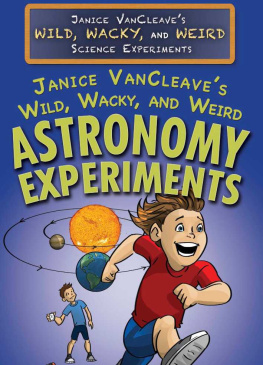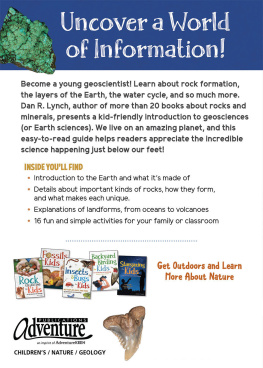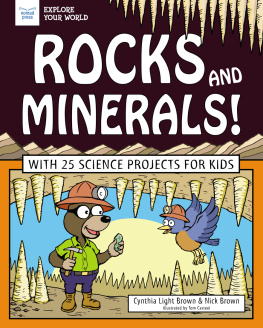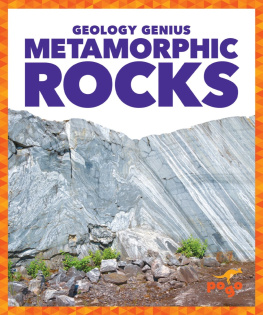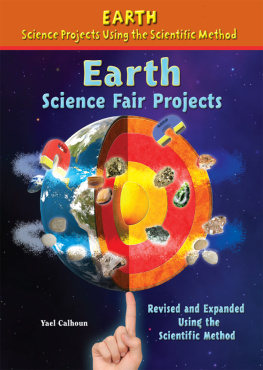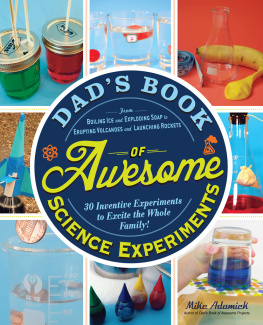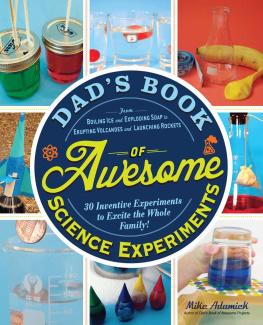This edition published in 2018 by
The Rosen Publishing Group, Inc.
29 East 21st Street
New York, NY 10010 Introduction and additional end matter 2018 by The Rosen Publishing Group, Inc. All rights reserved. No part of this book may be reproduced in any form without permission in writing from the publisher, except by a reviewer.
Library of Congress Cataloging-in-Publication Data Names: VanCleave, Janice Pratt. Title: Even more of Janice VanCleaves wild, wacky, and weird earth science experiments / Janice VanCleave. | Series: Janice VanCleaves wild, wacky, and weird science experiments | Audience: Grades 5-8. | Includes bibliographical references and index. | Includes bibliographical references and index.
Identifiers: LCCN 2017001882 | ISBN 9781499466898 (library-bound) | ISBN 9781499466942 (pbk.) | ISBN 9781499466805 (6-pack) Subjects: LCSH: Earth sciencesExperimentsJuvenile literature. | Science projectsJuvenile literature. Classification: LCC QE29 .V3627 2018 | DDC 550.78dc23 LC record available at https://lccn.loc.gov/2017001882 Manufactured in the United States of America Illustrations by Jim Carroll Experiments first published in Janice VanCleaves 200 Gooey, Slippery, Slimy, Weird and Fun Experiments by John Wiley & Sons, Inc. copyright 1992 Janice VanCleave CONTENTS Introduction NeedlesBubblesCrunchSedimentary SandwichLineupFoldsEasy Over?SlowerWavesRipplesCoveredRock EaterRunoffFly AwayCrack-UpHoldingRhythmicSprayerSpaceyStraw DrillDrippyUp and DownCloud WatcherWet Air Glossary For More Information For Further Reading Index INTRODUCTION Earth science is the study of Earth. Geology is one main area of earth science that deals with the study of our physical planet. But oceanography, meteorology, and astronomy are also branches of earth science.
The people who decide to work in the field of earth science have a variety of career paths to choose from. Some work in laboratories. Others work outdoors and study soil, fossils, volcanos, and earthquakes. All of these people have something in common: They are constantly asking questions to learn even more about our planet. This book is a collection of science experiments about earth science. HOW TO USE THIS BOOK You will be rewarded with successful experiments if you read each experiment carefully, follow the steps in order, and do not substitute materials. HOW TO USE THIS BOOK You will be rewarded with successful experiments if you read each experiment carefully, follow the steps in order, and do not substitute materials.
The following sections are included for all the experiments. PURPOSE: The basic goals for the experiment. MATERIALS: Alistofsuppliesyouwillneed. You will experience less frustration and more fun if you gather all the necessary materials for the experiments before you begin. You lose your train of thought when you have to stop and search for supplies. PROCEDURE: Step-by-step instructions on how to perform the experiment. Follow each step very carefully, never skip steps, and do not add your own. Safety is of the utmost importance, and by reading the experiment before starting, then following the instructions exactly, you can feel confident that no unexpected results will occur. Ask an adult to help you when you are working with anything sharp or hot.
If adult supervision is required, it will be noted in the experiment. RESULTS: An explanation stating exactly what is expected to happen. This is an immediate learning tool. If the expected results are achieved, you will know that you did the experiment correctly. If your results are not the same as described in the experiment, carefully read the instructions and start over from the first step. WHY? An explanation of why the results were achieved.THE SCIENTIFIC METHOD Scientists identify a problem or observe an event. Then they seek solutions or explanations through research and experimentation.
By doing the experiments in this book, you will learn to follow experimental steps and make observations. You will also learn many scientific principles that have to do with earth science. In the process, the things you see or learn may lead you to new questions. For example, perhaps you have completed the experiment that investigates whether water pressure is affected by volume. Now you wonder whether water pressure is affected by temperature. Thats great! All scientists are curious and ask new questions about what they learn.
When you design a new experiment, it is a good idea to follow the scientific method. Ask a question. Do some research about your question. What do you already know? Come up with a hypothesis, or a possible answer to your question. Design an experiment to test your hypothesis. Make sure the experiment is repeatable.
Collect the data and make observations. Analyze your results. Reach a conclusion. Did your results support your hypothesis? Many times the experiment leads to more questions and a new experiment. Always remember that when devising your own science experiment, have a knowledgeable adult review it with you before trying it out. Ask them to supervise it as well.NEEDLES PURPOSE To demonstrate how crystals form.
MATERIALS black construction paper scissors lid from a large jar measuring cup, 1 cup (250 ml) Epsom salt measuring spoon, tablespoon (15 ml) PROCEDURE Cut a circle from the black paper that will fit inside the lid. Place the paper in the lid. Fill the measuring cup with water (250 ml). Add 4 tablespoons (60 ml) of Epsom salt to the water and stir. Pour a very thin layer of the mixture into the lid. Allow the lid to stand undisturbed for one day.
RESULTS Long needle-shaped crystals form on the black paper. WHY? The Epsom salt molecules move closer together as the water slowly evaporates from the solution. The salt molecules begin to line up in an orderly pattern and form long needle-shaped crystals. The salt molecules stack together like building blocks, and the shape of the molecules determines the resulting shape of the crystal.
BUBBLES PURPOSE To demonstrate a positive test for limestone. MATERIALS 3 seashells vinegar glass PROCEDURE Fill a glass 1/4 full with vinegar.
Add the seashells. RESULTS Bubbles start rising from the seashells. WHY? Vinegar is an acid and seashells are made of limestone, a mineral. Limestone chemically changes into new substances when in contact with an acid. One of the new substances formed is carbon dioxide gas, and it is the bubbles of this gas that are seen rising in the glass of vinegar. Acid can be used to test for the presence of limestone in rocks.
If limestone is present in a rock, bubbles form when an acid touches the rock.
CRUNCH PURPOSE To demonstrate the formation of metamorphic rocks. MATERIALS 20 flat toothpicks book table PROCEDURE Snap the toothpicks in half, but leave them connected. Pile the toothpicks on a table. Place the book on top of the toothpick pile and press down. Remove the book.


